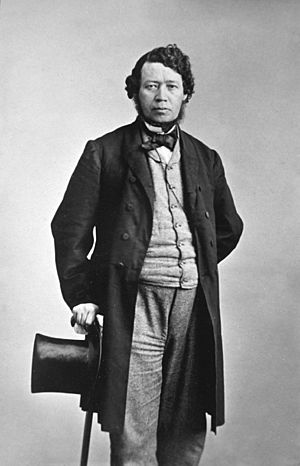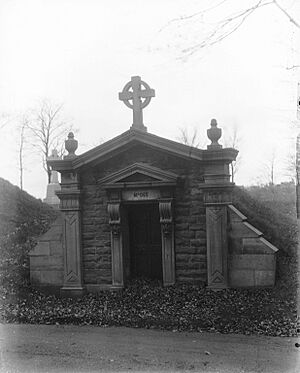Thomas D'Arcy McGee facts for kids
Quick facts for kids
Thomas D'Arcy McGee
|
|
|---|---|
 |
|
| Member of the Canadian Parliament for Montreal West |
|
| In office 24 September 1867 – 7 April 1868 |
|
| Preceded by | Riding established |
| Succeeded by | Michael Patrick Ryan |
| Personal details | |
| Born | 13 April 1825 Carlingford, County Louth, Ireland |
| Died | 7 April 1868 (aged 42) Ottawa, Ontario, Canada |
| Cause of death | Assassination (gunshot wound) |
| Political party | Liberal-Conservative |
| Relatives | Frank Charles McGee (great-nephew) |
| Signature | |
Thomas D'Arcy McGee (born April 13, 1825 – died April 7, 1868) was an important figure in Canadian history. He was an Irish-Canadian politician, a writer, and a poet. He is known as one of the Fathers of Confederation, helping to create Canada as a country.
When he was young, McGee was an Irish Catholic who did not like British rule in Ireland. He was part of a group called Young Ireland that wanted Ireland to be independent. He had to escape to the United States in 1848 to avoid arrest. Later, his political views changed a lot. He became less fond of American ideas and more supportive of the British Empire.
In 1857, he moved to the Province of Canada. He worked hard to convince other Irish Canadians to work with Canadian Protestants. His goal was to form a self-governing Canada that would still be part of the British Empire. His strong belief in Confederation earned him the name 'Canada's first nationalist'. McGee also spoke out against the Fenian Brotherhood. This was a secret group of Irish Republicans who wanted to fight the British.
McGee helped Canada become a country in 1867. Sadly, he was killed in 1868 by someone from the Fenian Brotherhood. They saw him as a traitor to their cause. Patrick J. Whelan, a member of the Fenian Brotherhood, was found guilty of his murder and was executed.
Contents
Early Life in Ireland
Thomas D'Arcy McGee was born on April 13, 1825, in Carlingford, Ireland. He was raised as a Roman Catholic. His mother taught him a lot about Irish history. This knowledge later shaped his writing and political work.
When he was eight, his family moved to Wexford. His father worked for the Irish coast guard there. In Wexford, McGee went to a local school. His teacher, Michael Donnelly, encouraged his love for learning. He learned about the long history of British rule and Irish resistance. This included the uprising of 1798.
In 1842, at age 17, McGee left Ireland with his sister. He sailed from Wexford to the United States. During his journey, he wrote many early poems about Ireland.
Life in the United States
In the United States, McGee quickly found work as an assistant editor. He worked for Boston Pilot, a Catholic newspaper in Boston. He wrote articles supporting Irish self-rule. By 1844, he became the main editor. He also wrote a lot about Irish literature and politics.
In 1845, he went back to Ireland. He became very active in politics and edited The Nation. This newspaper was the voice of the Young Ireland movement. In 1847, he married Mary Theresa Caffrey. They had six children, but only two daughters lived past their father.
McGee's involvement in the Irish Confederation and the Young Irelander Rebellion of 1848 led to an arrest warrant for him. He escaped by dressing as a priest and returned to the United States.
Back in the United States, he became well-known in Irish-American groups. He started and edited newspapers like the New York-based Nation and the Boston-based American Celt. He also wrote several history books.
Over time, McGee became unhappy with democracy and the United States. He felt that Canada was a better place for Irish Catholics. He moved to Montreal in 1857. He continued to criticize American ways of life. He believed Americans wanted to take over Canada and spread their ideas across North America. McGee strongly supported Canada staying loyal to the British Empire. He saw this as a way to protect Canada from American problems.
Moving to Canada

In 1857, McGee started a newspaper called the New Era in Montreal, Quebec. In his writings, he spoke out against the Orange Order. He also defended the right of Irish Catholics to have a voice in the government.
He believed in modernizing the economy. He called for building many railways, encouraging immigration, and using high tariffs to help Canadian manufacturing. In politics, he wanted to create a new Canadian identity. He hoped this would help Canada move past the old conflicts from Ireland. In 1858, he was elected to the Legislative Assembly of the Province of Canada. He worked hard for Canada to become an independent country. McGee also earned a law degree from McGill University in 1861.
McGee became the minister of agriculture, immigration, and statistics in 1863. He kept this job in the "Great Coalition" government. He was also a Canadian representative at the Charlottetown and Quebec conferences in 1864. These meetings were very important for planning Confederation. At the Quebec Conference, McGee proposed a rule to protect the education rights of religious minorities in Canada.
Speaking Out Against the Fenians
McGee changed his strong Irish nationalist views. He spoke out against the Fenian Brotherhood in America. This group wanted to take over Canada from Britain by force.
After Canada became a country, McGee was elected to the 1st Canadian Parliament in 1867. He represented Montreal West as a Liberal-Conservative. However, he had lost a lot of support from Irish Catholics because of his changed views.
On November 5, 1867, McGee gave a speech called "The Mental Outfit of the New Dominion." In this speech, he talked about Canadian literature. He suggested that Canada should have its own national literature inspired by the creativity of its people.
Assassination
On April 7, 1868, McGee was part of a long debate in Parliament. It lasted until after midnight. After the debate, he walked back to his boarding house in Ottawa. As he was opening the door, he was shot in the head by someone waiting inside. People rushed to the scene, but the killer was gone. It was later found that Patrick J. Whelan shot McGee with a handgun.
McGee was given a state funeral in Ottawa. It was one of the largest funerals in Canadian history. He was buried in a crypt at the Cimetière Notre-Dame-des-Neiges in Montreal. About 80,000 people attended his funeral procession in Montreal. This was a huge number, as the city's population was only about 105,000 at the time.
Patrick J. Whelan, who supported the Fenians, was accused, tried, and found guilty of the crime. He was hanged on February 11, 1869, in Ottawa. The jury was convinced by evidence that Whelan's gun had been fired recently. There was also evidence that he had threatened McGee. Some people have questioned if Whelan was truly the only person involved.
The government of Canada's Thomas D'Arcy McGee Building is located near where he was killed.
Impact of His Death
McGee's assassination was a very important event in Irish-Canadian history. It showed how strong the Fenian movement was among Irish Catholics in Canada during the 1860s. After McGee's death, no other moderate Irish leader stepped up to unite people.
The Catholic bishops also found it hard to control the Fenians in both the US and Canada. Canadian politicians who were not Catholic also tried to win the votes of Irish Catholics. All these factors led to a fear of American Fenianism in Canada. After 1870, the Fenian raids into Canada failed. This led to the decline of Fenian power in both the US and Canada.
Honours and Legacy
There is a monument to McGee at Tremone Bay in Ireland. This is near the bay where he escaped to North America in 1848. Another monument stands in his hometown of Carlingford, County Louth. It was unveiled in 1991 by former Prime Minister of Canada Brian Mulroney. A plaque from the Canadian government marks his parents' grave in Wexford, Ireland.
From August 20-22, 2012, the first Thomas D'Arcy McGee Summer School was held in Carlingford. It celebrated his life and legacy.
In downtown Ottawa, the Thomas D'Arcy McGee Building is a well-known government office building. D'Arcy McGee's Pub is also on the corner of Sparks and Elgin streets.
Several schools are named in his honour:
- D'Arcy McGee Catholic School (elementary, Toronto, Ontario)
- Thomas D'Arcy McGee Catholic School (elementary, Ottawa, Ontario)
- D'Arcy McGee High School (Aylmer, Quebec)
The Quebec provincial election area of D'Arcy-McGee is named after him. Also, two villages in central Saskatchewan are named after him: D'Arcy and McGee.
In 1986, a special program for Irish Studies was created in his honour at Saint Mary's University in Halifax. In 2005, the gun used to assassinate McGee was bought by the Canadian Museum of Civilization for $105,000.
Electoral history
| Canadian federal election, 1867: Montreal West | ||||||||
|---|---|---|---|---|---|---|---|---|
| Party | Candidate | Votes | ||||||
| Liberal–Conservative | Thomas D'Arcy McGee | 2,676 | ||||||
| Liberal | Bernard Devlin | 2,477 | ||||||


